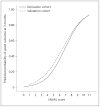Posttreatment variables improve outcome prediction after intra-arterial therapy for acute ischemic stroke
- PMID: 24942008
- PMCID: PMC4157916
- DOI: 10.1159/000362591
Posttreatment variables improve outcome prediction after intra-arterial therapy for acute ischemic stroke
Abstract
Background: There are multiple clinical and radiographic factors that influence outcomes after endovascular reperfusion therapy (ERT) in acute ischemic stroke (AIS). We sought to derive and validate an outcome prediction score for AIS patients undergoing ERT based on readily available pretreatment and posttreatment factors.
Methods: The derivation cohort included 511 patients with anterior circulation AIS treated with ERT at 10 centers between September 2009 and July 2011. The prospective validation cohort included 223 patients with anterior circulation AIS treated in the North American Solitaire Acute Stroke registry. Multivariable logistic regression identified predictors of good outcome (modified Rankin score ≤2 at 3 months) in the derivation cohort; model β coefficients were used to assign points and calculate a risk score. Discrimination was tested using C statistics with 95% confidence intervals (CIs) in the derivation and validation cohorts. Calibration was assessed using the Hosmer-Lemeshow test and plots of observed to expected outcomes. We assessed the net reclassification improvement for the derived score compared to the Totaled Health Risks in Vascular Events (THRIVE) score. Subgroup analysis in patients with pretreatment Alberta Stroke Program Early CT Score (ASPECTS) and posttreatment final infarct volume measurements was also performed to identify whether these radiographic predictors improved the model compared to simpler models.
Results: Good outcome was noted in 186 (36.4%) and 100 patients (44.8%) in the derivation and validation cohorts, respectively. Combining readily available pretreatment and posttreatment variables, we created a score (acronym: SNARL) based on the following parameters: symptomatic hemorrhage [2 points: none, hemorrhagic infarction (HI)1-2 or parenchymal hematoma (PH) type 1; 0 points: PH2], baseline National Institutes of Health Stroke Scale score (3 points: 0-10; 1 point: 11-20; 0 points: >20), age (2 points: <60 years; 1 point: 60-79 years; 0 points: >79 years), reperfusion (3 points: Thrombolysis In Cerebral Ischemia score 2b or 3) and location of clot (1 point: M2; 0 points: M1 or internal carotid artery). The SNARL score demonstrated good discrimination in the derivation (C statistic 0.79, 95% CI 0.75-0.83) and validation cohorts (C statistic 0.74, 95% CI 0.68-0.81) and was superior to the THRIVE score (derivation cohort: C statistic 0.65, 95% CI 0.60-0.70; validation cohort: C-statistic 0.59, 95% CI 0.52-0.67; p < 0.01 in both cohorts) but was inferior to a score that included age, ASPECTS, reperfusion status and final infarct volume (C statistic 0.86, 95% CI 0.82-0.91; p = 0.04). Compared with the THRIVE score, the SNARL score resulted in a net reclassification improvement of 34.8%.
Conclusions: Among AIS patients treated with ERT, pretreatment scores such as the THRIVE score provide only fair prognostic information. Inclusion of posttreatment variables such as reperfusion and symptomatic hemorrhage greatly influences outcome and results in improved outcome prediction.
© 2014 S. Karger AG, Basel.
Conflict of interest statement
None of the other authors have any relevant interests to declare.
Figures



Similar articles
-
Optimizing prediction scores for poor outcome after intra-arterial therapy in anterior circulation acute ischemic stroke.Stroke. 2013 Dec;44(12):3324-30. doi: 10.1161/STROKEAHA.113.001050. Epub 2013 Aug 8. Stroke. 2013. PMID: 23929748 Free PMC article.
-
Trial design and reporting standards for intra-arterial cerebral thrombolysis for acute ischemic stroke.Stroke. 2003 Aug;34(8):e109-37. doi: 10.1161/01.STR.0000082721.62796.09. Epub 2003 Jul 17. Stroke. 2003. PMID: 12869717
-
Prediction of Early Neurological Deterioration in Individuals With Minor Stroke and Large Vessel Occlusion Intended for Intravenous Thrombolysis Alone.JAMA Neurol. 2021 Mar 1;78(3):321-328. doi: 10.1001/jamaneurol.2020.4557. JAMA Neurol. 2021. PMID: 33427887 Free PMC article.
-
Is bridging with intravenous thrombolysis of any benefit in endovascular therapy for acute ischemic stroke?World Neurosurg. 2014 Sep-Oct;82(3-4):e453-8. doi: 10.1016/j.wneu.2013.01.097. Epub 2013 Feb 1. World Neurosurg. 2014. PMID: 23376392 Review.
-
Endovascular treatment or general treatment: how should acute ischemic stroke patients choose to benefit from them the most?: A systematic review and meta-analysis.Medicine (Baltimore). 2020 May;99(20):e20187. doi: 10.1097/MD.0000000000020187. Medicine (Baltimore). 2020. PMID: 32443338 Free PMC article.
Cited by
-
Stent Retriever-Based Thrombectomy in Octogenarians.Interv Neurol. 2016 Sep;5(3-4):111-117. doi: 10.1159/000446795. Epub 2016 Jun 4. Interv Neurol. 2016. PMID: 27781038 Free PMC article.
-
Thinking About the Future: A Review of Prognostic Scales Used in Acute Stroke.Front Neurol. 2019 Mar 21;10:274. doi: 10.3389/fneur.2019.00274. eCollection 2019. Front Neurol. 2019. PMID: 30949127 Free PMC article. Review.
-
The changes in clot microstructure in patients with ischaemic stroke and the effects of therapeutic intervention: a prospective observational study.BMC Neurol. 2015 Mar 15;15:35. doi: 10.1186/s12883-015-0289-1. BMC Neurol. 2015. PMID: 25885595 Free PMC article.
-
Mechanical Thrombectomy for Large Ischemic Stroke: A Systematic Review and Meta-analysis.Neurology. 2023 Aug 29;101(9):e922-e932. doi: 10.1212/WNL.0000000000207536. Epub 2023 Jun 5. Neurology. 2023. PMID: 37277200 Free PMC article.
-
Development and Validation of a Postprocedural Model to Predict Outcome After Endovascular Treatment for Ischemic Stroke.JAMA Neurol. 2023 Jul 31;80(9):940-8. doi: 10.1001/jamaneurol.2023.2392. Online ahead of print. JAMA Neurol. 2023. PMID: 37523199 Free PMC article.
References
-
- Towfighi A, Saver JL. Stroke declines from third to fourth leading cause of death in the United States: historical perspective and challenges ahead. Stroke. 2011;42:2351–2355. - PubMed
-
- Adams HP, Jr, del Zoppo G, Alberts MJ, et al. Guidelines for the early management of adults with ischemic stroke: a guideline from the American Heart Association/American Stroke Association Stroke Council, Clinical Cardiology Council, Cardiovascular Radiology and Intervention Council, and the Atherosclerotic Peripheral Vascular Disease and Quality of Care Outcomes in Research Interdisciplinary Working Groups: the American Academy of Neurology affirms the value of this guideline as an educational tool for neurologists. Stroke. 2007;38:1655–1711. - PubMed
-
- Flint AC, Kamel H, Rao VA, et al. Validation of the Totaled Heath Risks In Vascular Events (THRIVE) score for outcome prediction in endovascular stroke treatment. Int J Stroke. 2014;9:32–39. - PubMed
MeSH terms
Substances
Grants and funding
LinkOut - more resources
Full Text Sources
Other Literature Sources
Medical

